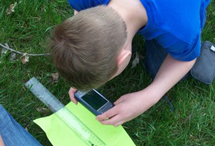
Starting small might be the key to success when it comes to deploying a mobile learning initiative, according to two educators whose district has implemented a successful mobile program that now reaches 500 students.
“We felt that if it was something that was going to catch on, we wanted to be sure that we started small and that it was as group of people who wanted to work at this,” said Kyle Menchhofer, technology director for the St. Marys City Schools district in Ohio. “Starting small was a very strong and successful part of why we are where we are at this time.”
In 2008, before smart phones caught on, the district started its pilot by purchasing personal digital assistants (PDAs). Eight teachers—two each from third, fourth, and fifth grade—and two resource teachers signed on to begin the program.
“The biggest thing is starting out small,” said Scott Newcomb, a fifth grade teacher in the district. “Sometimes, giving everyone an iPad is too much—the goal or objective might get lost.”
See also:
How to make BYOD work for your schools
The pilot team attended training sessions every three to four weeks, and Menchhofer said professional development was a priority above all else. The district also formed a team of teachers who experimented with the PDAs to discover new uses and classroom applications.
“We didn’t want to create additional work for our teachers,” Menchhofer said. “We didn’t want to make this a burden on our staff.”
In 2008, 155 students participated in the pilot, which included 120 PDAs and GoKnow software. Shortly after the pilot began, district IT staff discovered that the hardware company from which they purchased the PDAs decided to produce smart phones instead. By the spring of the pilot year, the district partnered with Verizon Wireless and had 30 smart phones to use in a trial program.
“Funding is an issue, but you have to set priorities,” Menchhofer said.
In the program’s second year, 30 teachers and 644 students participated, with 575 mobile devices and 72 PDAs in grades 3-6. By the fourth year, 500 students were using 500 devices and the district began to introduce a “bring your own device” policy.
Instead of “smart phone,” district tech staff and educators use the term “mobile learning device” (MLD) to avoid any negative connotation associated with smart phones, said Menchhofer, who added that the term “smart phone” causes some parents to assume immediately their children might spend time playing games and doing other off-task activities.
“We call them MLDs, because it is a mobile learning device, and we truly believe that,” he said.
Cell phone and texting services are turned off on the devices, and only internet access works.
In its fifth year, the district is partnering with Alltel and operates on a full BYOD policy.
Keys for successful MLD implementation include:
- Educators, leaders can see mobile learning in action
- Constant, stead professional development
- Teachers sharing ideas
- Teachers teaching teachers
See also:
How to make BYOD work for your schools
Newcomb said that even though every student in grades 3-5 has an MLD, many students bring their own devices, such as an iPod Touch or a Kindle Fire.
“I’ve never had any issues with it,” he said. “These kids are responsible. A lot of people lead with fear and say these kids can’t handle [an expensive device]. I’ve noticed a lot of responsibility.”
The district turned to mobile devices for a variety of reasons, Menchhofer said.
1. A lack of computers: The district did not have a dedicated computer lab. It did have laptop labs, but long waiting lists delayed teachers’ and students’ ability to use the laptops in a timely manner.
2. Current technology was not sufficient: Various editions of Microsoft Office created maintenance and functionality roadblocks.
3. Expenses related to laptops and Wi-Fi: District technology staff had to move Wi-Fi access points from classroom to classroom.
Newcomb said the program has had an overwhelmingly positive impact on students and teachers, because both groups are much more engaged in their lessons and spend more time on task.
“Students who weren’t always participating are the ones who are opening up now,” he said. Some teachers might be afraid to relinquish classroom control when students know more about the smart phones than teachers do, but Newcomb said he leverages students’ knowledge and lets them come to the front of his classroom to share what they have discovered.
“The overall goal is to provide a positive learning experience for every student,” Menchhofer said. “There are people who will challenge what you’re doing, but the people who challenge you will not come in to see what your students and teachers are doing, because they’ll be proven wrong.”
The district penalizes students for inappropriate use of the devices, and Menchhofer said that students learn early on what is and is not appropriate for in-school use.
“Mobile learning reaches all learners,” Newcomb said, adding that many of his special-education students have really benefited from using smart phones in class.
See also:
How to make BYOD work for your schools
- Friday 5: Universal Design for Learning - April 19, 2024
- Educators love their edtech, but want more training - April 18, 2024
- Friday 5: College and career readiness - April 12, 2024


Comments are closed.